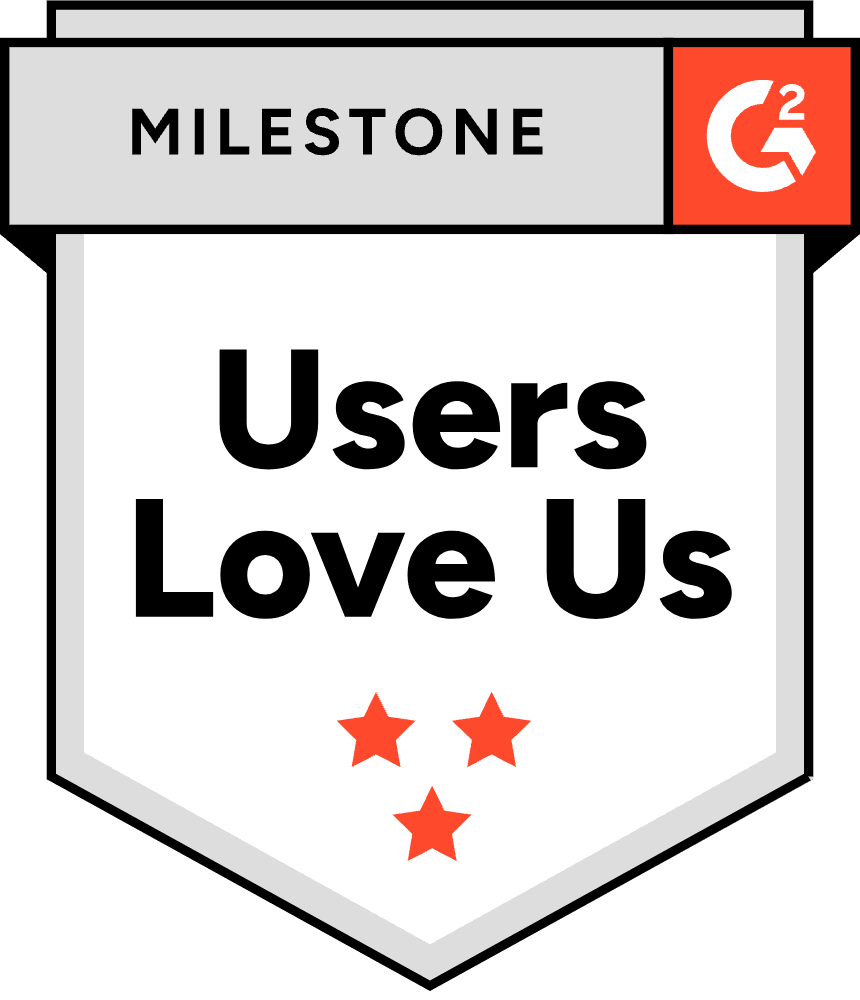At first glance it feels smart to buy an email list from a big database. One payment, a long list of contacts, more reach for your team. In practice many lists fail. Bounce rates climb, reply rates drop and your sender reputation slips.
A lot of email list databases pack old or unverified data. Some also ignore consent rules. That hurts your campaigns and can expose you to fines.
This guide helps you pick the best email list database for your goals. You see what to check before you buy email lists: data source, legal compliance, verification, data freshness, fit with your ICP and deliverability.
You also see which providers stand out and how each one works. With that you can choose a list source that supports your pipeline instead of weakens it.
Let’s get started.
What Are the Best Email List Databases?
The best sites to buy email lists are UpLead, Apollo, Cognism and ZoomInfo. These tools give you compliant, up to date B2B contact data. You reach the right people and avoid cold email to poor lists. Your budget and target market also matter. Other providers in this guide fit niche needs such as verification, enrichment or Europe focused outreach.
Use this quick comparison to see which provider fits your sales and marketing goals.
| Database | Best For | Pricing | USP |
|---|---|---|---|
|
|
Data accuracy and real time verification | Free trial available, $74-$199/month (annual) | 95% data accuracy guarantee with credit refunds for bounces |
|
|
All in one B2B sales platform | Free tier available; $49-$119/user/month | Complete stack (data + sequencer + dialer) in one platform |
|
|
GDPR compliant EMEA B2B data | Custom pricing | Human-verified Diamond Data with 87% connect rate |
|
|
Triple verified B2B email data | From $49/month | Triple verification process with intent triggers |
|
|
Domain based email discovery and verification | $34-$209/month (annual) | Fast email finding and verification with generous free tier |
|
|
Low cost email and phone data | From $39/month | Large database with affordable pricing tiers |
|
|
LinkedIn first B2B contact data | €45-€79/user/month (annual) | Lightweight extension with unlimited B2B emails |
|
|
Human verified B2B contact data | Custom pricing | Human-verified contacts plus Research-on-Demand service |
|
|
LinkedIn capture and CRM sync | $15-$79/user/month | One-click capture from LinkedIn with job change tracking |
|
|
LinkedIn email discovery at scale | From $30/month | Bulk email extraction from LinkedIn with domain search |
|
|
Enterprise grade global B2B database | From ~$1,250/month (annual) | Comprehensive global database with deep firmographics |
|
|
Simple contact data for SMBs | $22.45-$52.45/user/month (annual) | Browser extension for instant contact capture |
|
|
AI based B2B list tool | From $147/user/month (annual) | AI-powered prospecting with real-time search |
Best 15 Places to Buy Email Lists Compared
The best places to buy email lists include reputable providers that specialize in email marketing lists. These providers ensure high-quality, targeted lists that align with your business needs. It’s critical to select platforms that offer up-to-date and compliant databases to maximize your marketing strategies.
Let’s have a look at all the tools in detail.
UpLead
Best for Data Accuracy and Real-Time Verification
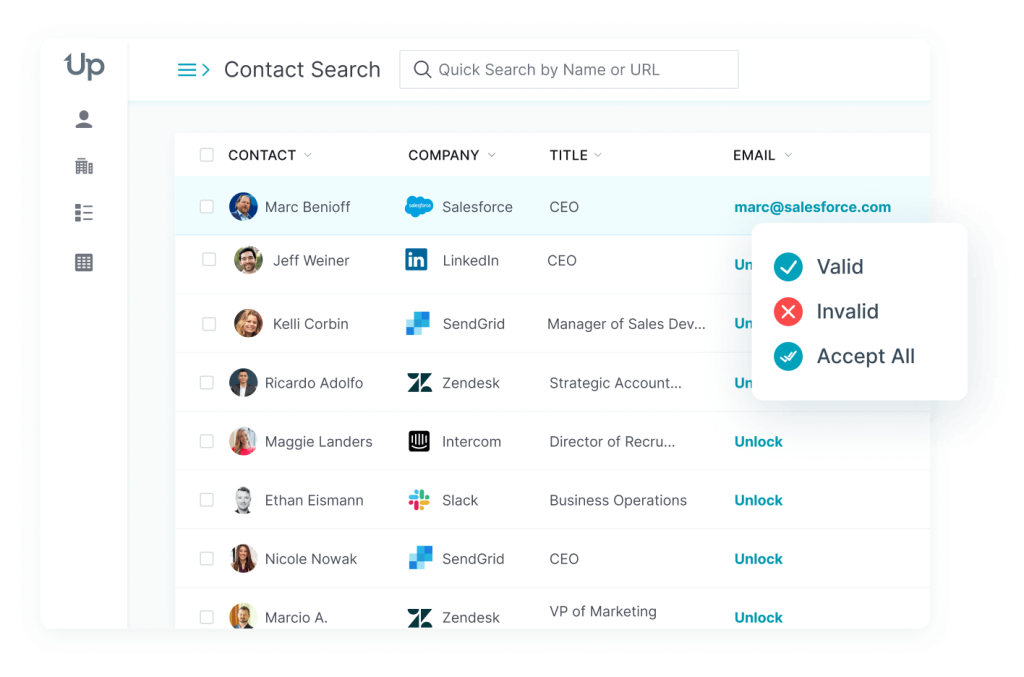
UpLead is a tool to buy email lists that stands out by giving you access to over 180 million professional profiles worldwide. With a promise of 95% accuracy, it guarantees verified email addresses and ensures high-quality leads for your business.
UpLead is not just about buying email mailing lists; it enhances your marketing strategy by providing real-time email verification, extensive filters for targeted search and integration with over 1,500 platforms.
Whether you want to buy business email lists or create targeted marketing campaigns, UpLead’s real time prospecting and advanced search capabilities makes it the go to platform.
Pricing
-
- Free trial: 7 days free with 5 leads
-
- Essentials: $99/month, or $74/month when billed annually
-
- Plus: $199/month, or $149/month when billed annually
-
- Professional: Custom pricing
Features
-
- 95% Data Accuracy Guarantee: UpLead commits to high accuracy in contact data.
-
- Extensive Search Filters: Use over 50 criteria for precise prospect targeting.
-
- Advanced Prospecting: Access over 180 million B2B profiles for lead generation.
-
- Real-time Email Verification: Ensures high deliverability by verifying emails instantly.
-
- Mobile Direct Dials: Get mobile & direct dial phone numbers for prospects
-
- Instant List Updates: Keeps data fresh with real-time refreshes as filters are applied.
-
- Chrome Extension: Gather email addresses from LinkedIn or websites with ease.
-
- Intent Data: Get ready-to-buy prospects who look for your solution.
Pros
-
- Real-time email verification delivers exceptional accuracy with minimal bounces
-
- Cost-effective pricing compared to enterprise alternatives
-
- Intuitive interface requires no learning curve
-
- Responsive customer support with proactive assistance
-
- 50+ search filters enable precise targeting
Cons
-
- Occasional data quality variations for certain contacts
-
- Geographic coverage stronger in North America than other regions
Start with UpLead today and grab 5 free leads.
⚖️ What I Like About UpLead
UpLead treats email lists as something you can trust, not as a black box. The 95% accuracy guarantee gives you a clear promise. Real time verification keeps bad records out of your campaigns and protects your domain. The search filters help you move from a broad idea of your ICP to a tight list in a few clicks. If you want one provider that feels safe to hand to a new SDR, UpLead works very well.
Apollo
Best for All-in-One B2B Sales Platform
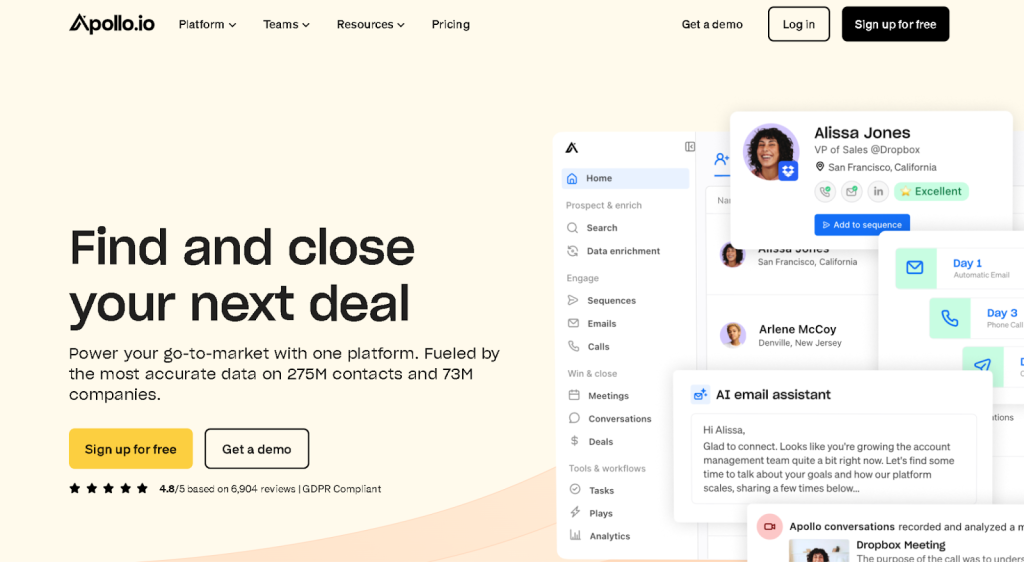
Apollo.io is good for segmenting databases for email list buyers. Trusted by over a million professionals it automates email campaigns, integrates with CRMs and social platforms like LinkedIn and maintains email list hygiene. It helps you manage your contacts to boost engagement.
Pricing
-
- Free: $0
-
- Basic: from $49/user/month
-
- Professional: from $79/user/month
-
- Organization: from $119/user/month
Here, you can learn more about the Apollo pricing.
Features
-
- Email Automation: Apollo simplifies your email marketing efforts by automating tasks like segmenting subscribers, executing marketing sequences, scheduling and generating performance reports.
-
- Affordable Market Expansion: With Apollo, expand your reach with curated email lists and tap into an audience that’s already shown interest.
-
- Email Templates: Apollo offers ready-to-use email templates and snippets for quick campaign launches.
-
- Risk Reduction: Minimize campaign risks with Apollo’s A/B testing, detailed analytics and data reliability to enhance your outbound success.
Pros
-
- 200M+ contact database with comprehensive filtering
-
- All-in-one platform combines prospecting, automation and CRM integration
-
- Intuitive interface with minimal learning curve
-
- Cost-effective compared to enterprise alternatives
-
- Free plan with substantial monthly credits
Cons
-
- Customer support quality has deteriorated during rapid scaling
-
- Data accuracy inconsistencies reported by users
-
- Recent credit system changes frustrate annual subscribers
-
- Provides headquarters numbers rather than direct lines
If Apollo doesn’t look like a fit to you, have a look at the best Apollo.io alternatives.
Lead generation doesn’t have to be all that painful. With UpLead, you can easily connect with high-quality prospects and leads to grow your company.
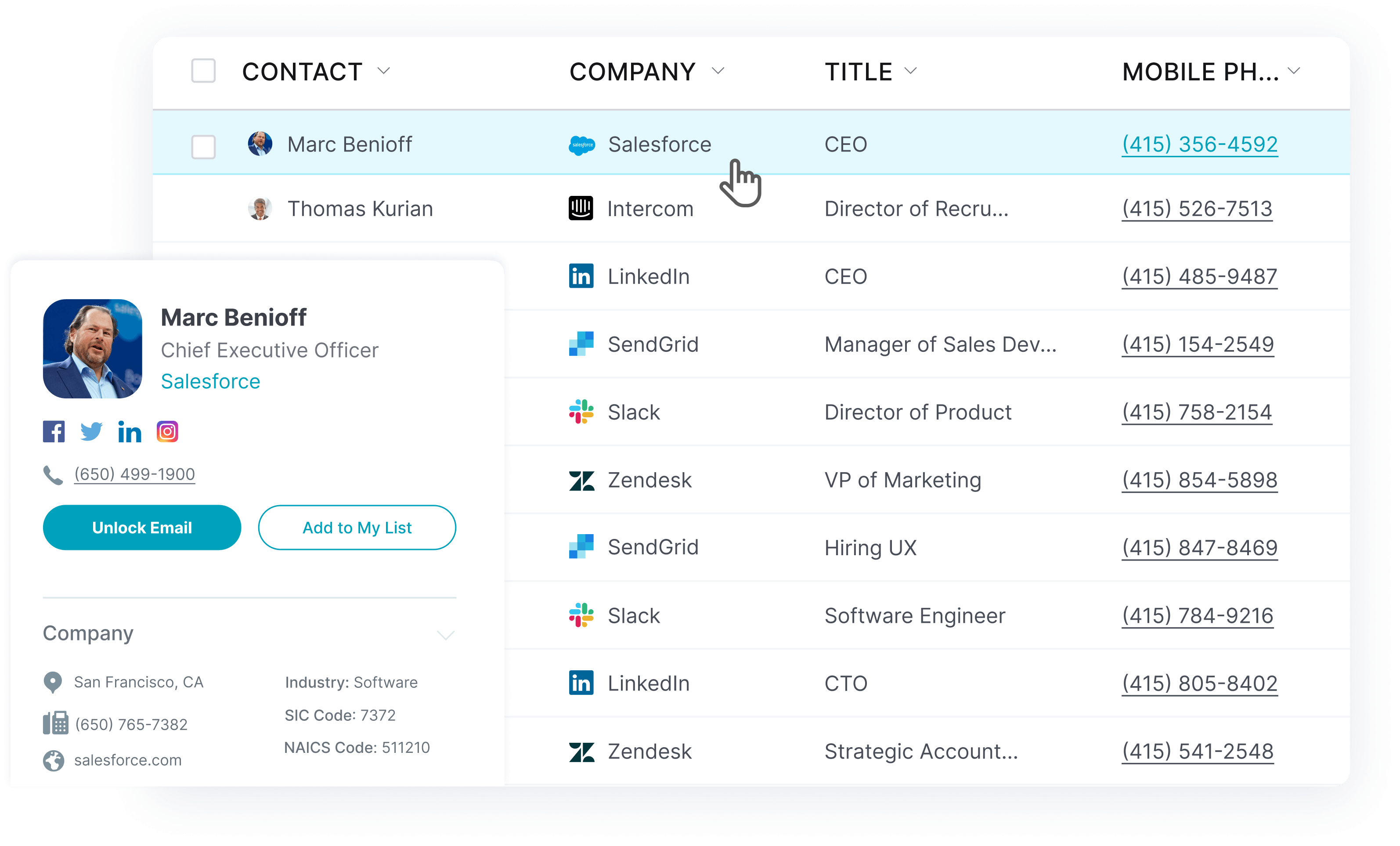
⚖️ What I Like About Apollo
Apollo shines when you want more than a static list. You search for contacts, drop them into sequences and track what happens in one place. That keeps the handoff between “find” and “outreach” simple for your team. It suits sales orgs that already run high volume outbound and want their list source inside the same workspace as calls and emails.
Cognism
Best for GDPR Compliant EMEA B2B Data
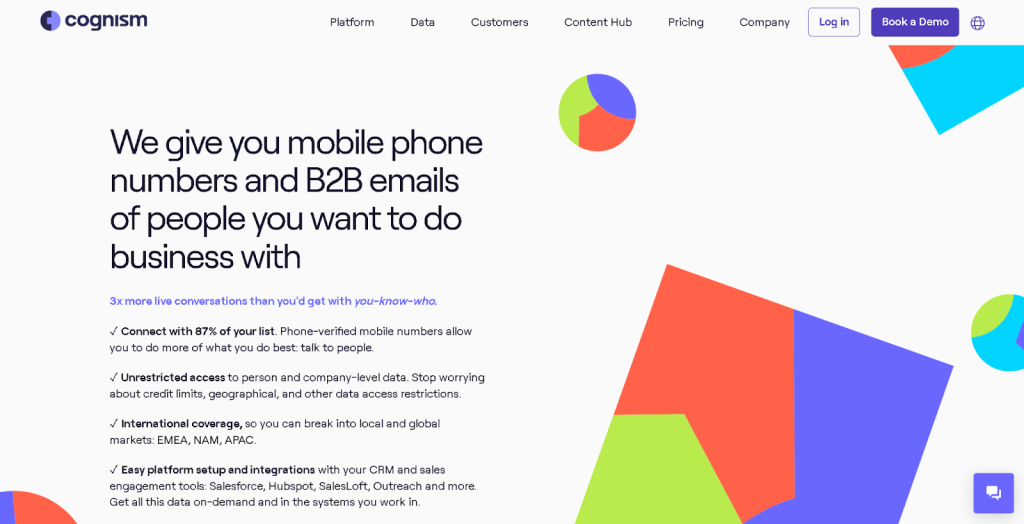
Cognism is a B2B sales intelligence tool that helps you create and buy targeted email lists for global campaigns. It’s a platform where you can search the database and build lead lists that match your Ideal Customer Profile (ICP) and export validated emails to CRM or sales tools.
This tool is GDPR and CCPA compliant and ISO certified so you can expand your reach while being privacy compliant. It integrates with sales and marketing platforms like Salesforce and HubSpot so you can use your data with ease.
Pricing
-
- Custom pricing (find more information about the Cognism pricing)
Features
-
- Targeted Email Lists: Cognism allows you to create specialized email lists for international campaigns and reach high-value prospects.
-
- Data Compliance: Ensures email lists are GDPR and CCPA compliant so you can market in an ethical and legal way.
-
- CRM Integration: Integration with leading CRMs like Salesforce and HubSpot for smooth workflows.
-
- Intent-Based Data: Consent-based intent data to find potential customers and boost your marketing campaigns.
Pros
-
- Diamond Data phone verification achieves 87% accuracy with 3x better connection rates
-
- Superior EMEA/UK data coverage outperforms competitors
-
- Exceptional customer support with 20-second response times
-
- Seamless CRM integrations reduce prospecting time by 70-90%
Cons
-
- Premium pricing prohibitive for small businesses
-
- Auto-renewal issues with insufficient advance notice
-
- Data accuracy inconsistencies despite verification efforts
-
- Weaker APAC/Asian market coverage
-
- No free trial with pricing revealed only through demos
(If you’re looking for something similar to Cognism: UpLead is a great Cognism alternative.)
⚖️ What I Like About Cognism
Cognism stands out with its strength in EMEA data and its clear focus on compliance. The Diamond Data phone numbers help calling teams reach real decision makers in the UK and Europe. If you run many cold calls into those markets and your legal team cares about GDPR, Cognism gives you more comfort than a generic list seller.
Lead411
Best for Triple Verified B2B Email Data
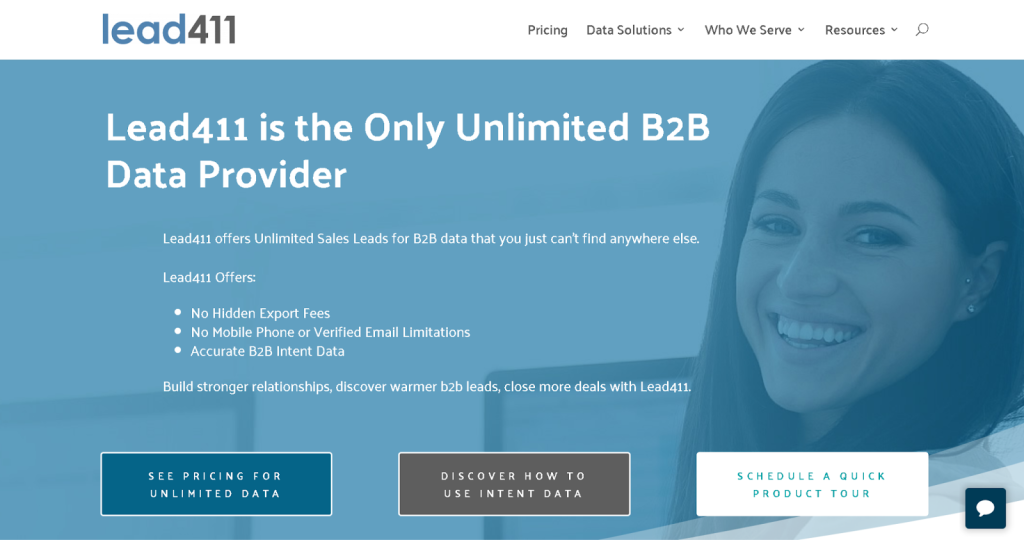
Lead411 is a B2B email list provider that offers subscriptions to their B2B email database. They have a high verified email rate thanks to their triple verification process that combines algorithms, A.I. and human research. Customers can filter their email lists by job titles, company size and industry etc. They also offer additional data like social profiles and direct dial phone numbers so you can get complete information when you buy marketing lists.
Pricing
-
- Free trial: $0 for 7 days (limited free exports)
-
- Spark: from $49/month or $490/year (annual billing)
-
- Ignite & Blaze: custom pricing based on seats and export volumes
Features
-
- Triple Verified Emails: Lead411 verifies their emails with SMTP checks, human validation and email open confirmation.
-
- Advanced Search: Filter by job title, company size and more to target your campaigns.
-
- Data Integrations: Integrates with over 25 CRMs and marketing platforms.
-
- Direct Dial Numbers: Double checked phone numbers.
Pros
-
- Triple-verified emails deliver high accuracy
-
- Lower cost than enterprise alternatives
-
- Bombora intent data integration identifies active buyers
-
- Sales triggers provide conversation starters
-
- Responsive customer support with thorough training
Cons
-
- Outdated interface frustrates users
-
- Slow site load with heavy user loads
-
- Data accuracy inconsistencies undermine high marks
-
- Limited filtering capabilities compared to competitors
-
- Chrome extension requires frequent updates
⚖️ What I Like About Lead411
Lead411 links verified emails with intent signals and trigger events. You do not only see who fits your target profile. You also see who just raised funding or made a key hire. That mix of fit plus timing makes it easier to build smaller lists that convert well instead of huge, cold databases.
Hunter
Best for Domain Based Email Discovery and Verification
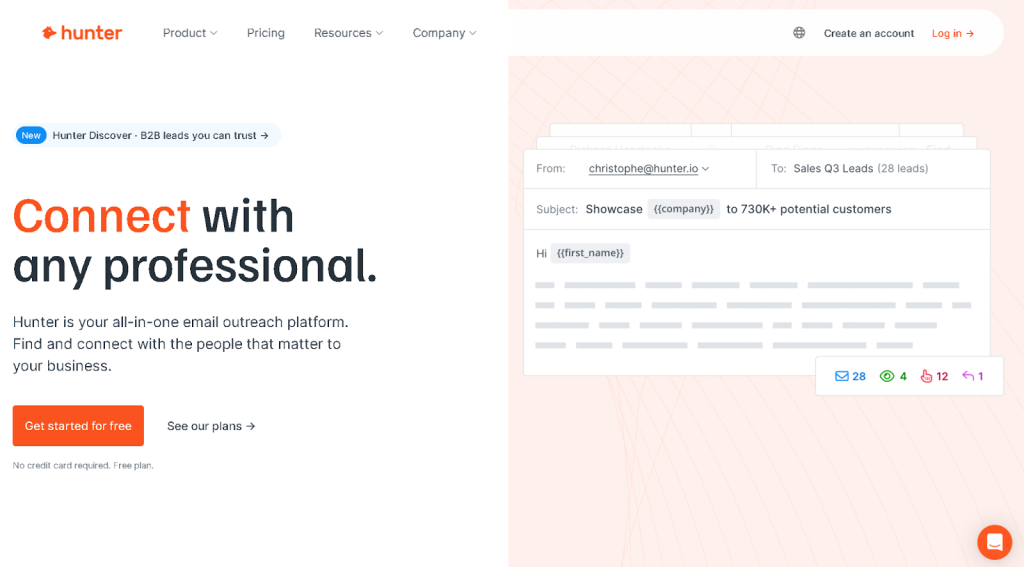
Hunter.io is known for finding and verifying professional email addresses and has over 4 million users. They offer domain search, email finding and verification tools and ensure high quality data GDPR compliant. Good for building and buying email lists, Hunter.io is easy to use but can also get expensive (check Hunter’s pricing).
Pricing:
-
- Free: $0/month (limited searches)
-
- Starter: $49/month, or $34/month when billed annually
-
- Growth: $149/month, or $104/month when billed annually
-
- Scale: $299/month, or $209/month when billed annually
-
- Enterprise: Custom pricing
Features
-
- Domain Search: Find the best contact for a company name or website and tailor your approach to your ideal customer profile.
-
- Email Finder: Use a name to find a verified email address and get the most out of your list with high accuracy.
-
- Email Verifier: Improve your sender reputation by ensuring email addresses are valid and can receive messages and reduce bounces.
-
- Bulk Tasks: Manage large volumes of email addresses by performing bulk search, check and verification.
Pros
-
- No learning curve with intuitive interface
-
- Fast access to decision-maker emails
-
- Email verification accuracy reaches high levels with transparent confidence scores
-
- Quick and helpful customer support
-
- Clean platform design avoids clutter
Cons
-
- Pricing higher than competitors for verification
-
- Free plan’s credit limit too restrictive
-
- Missing features include LinkedIn integration and phone numbers
-
- Occasional data inaccuracies with verified emails still bouncing
-
- Database coverage gaps in certain geographic regions
If you’re looking for similar solutions, check out these Hunter.io alternatives.
⚖️ What I Like About Hunter
Hunter keeps things very clear. You give it a domain or a name and it gives you likely email patterns with a confidence score. That helps you enrich a small list fast or fill gaps when other tools miss a contact. It works best when you need simple, clean email discovery instead of a full sales platform.
RocketReach
Best for Low Cost Email and Phone Data
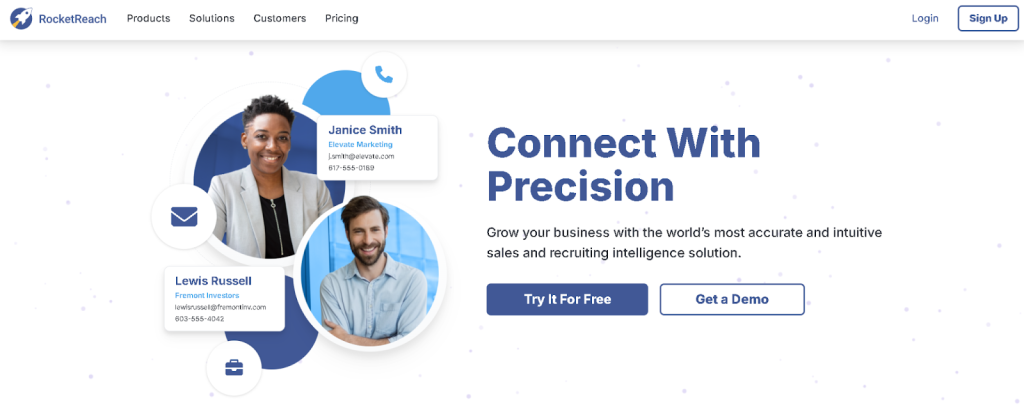
RocketReach provides global email and phone contact data with a 90-98% deliverability rate for verified emails.
You can create custom contact and company lists that update based on location and industry. RocketReach also has intent data to find potential buyers and AI powered recommendations to find new contacts.
It integrates with CRM and marketing automation platforms and also has an API for data enrichment.
Pricing
-
- Free: $0
-
- Essentials: from $39 per month
-
- Pro: from $99 per month
-
- Ultimate: from $249 per month
Features
-
- Database: Access a database of over 275 million verified contacts categorized by industry, company size and job title.
-
- Verified Email Lists: Get email lists that have gone through a multi-step verification process.
-
- Advanced Filtering: Create targeted email lists with advanced filtering by seniority level, technology usage and intent data.
-
- Integrations: Integrate your acquired email lists into your CRM and marketing automation tools or export as CSV files.
-
- LinkedIn Integration: Enhance your email lists by importing and enriching contact information from LinkedIn profiles.
-
- Real-time Data Enrichment: Keep your contact data up to date and accurate with real-time data enrichment.
Pros
-
- Large database with extensive coverage
-
- LinkedIn Chrome extension earns consistent praise
-
- Cheaper than enterprise tools
-
- Intuitive interface accessible to new users
-
- Advanced search filters enable precise targeting
Cons
-
- Data accuracy problems with high bounce rates
-
- Phone number accuracy poor
-
- Customer service problems intensify during disputes
-
- Auto-renewal complaints increased
-
- Geographic coverage gaps in international markets
⚖️ What I Like About RocketReach
RocketReach balances reach and price. The database covers many roles and regions and the entry plans stay within range for small teams. The Chrome extension feels simple and lets you grab data while you research accounts. It suits companies that test new markets or channels and need a broad, low friction source of email and phone data.
Kaspr
Best for LinkedIn First B2B Contact Data

Kaspr has access to email lists with over 500 million phone numbers and email addresses for B2B lead gen. It works for individual SDRs, small sales teams and recruiters. Kaspr has a Chrome Extension and offers different CRM integrations. The tool also provides you with real-time data verification from 150 B2B data sources. It’s GDPR and CCPA compliant and you can get email addresses and phone numbers in the US and Europe.
Pricing
-
- Free: €0/month
-
- Starter: €59/user/month, or €45/user/month when billed annually
-
- Business: €99/user/month, or €79/user/month when billed annually
-
- Organization: Custom pricing
Features
-
- Up-to-Date Contact Information: Get current contact details including phone numbers and email addresses verified against 150 providers and updated in real-time.
-
- Unlimited B2B Contacts: Get unlimited B2B email contacts across all plans including the free plan.
-
- LinkedIn Integration: Chrome Extension to get contact details from LinkedIn profiles including Sales Navigator and Recruiter Lite.
-
- CRM and Marketing Automation Sync: Integrates with leading CRM and marketing automation tools like HubSpot, Pipedrive, Lemlist and Salesforce for data sync and workflow.
-
- Compliance: Fully GDPR and CCPA compliant
-
- User Friendly Interface: Dashboard to manage leads, including list creation, note-taking and task assignment.
Pros
-
- Chrome extension provides instant contact access from LinkedIn
-
- Simple interface with easy credit access
-
- Quick contact information retrieval in few clicks
-
- Strong European phone number data coverage
Cons
-
- Trust issues with massive rating disparity across platforms
-
- Data inaccuracy complaints include outdated contact information
-
- Auto-renewal enabled by default with difficult cancellation
-
- Inconsistent support quality
-
- Bulk enrichment features require additional expensive tools
⚖️ What I Like About Kaspr
Kaspr lives close to LinkedIn, which keeps the workflow light for SDRs. You view a profile and reveal email and phone details without juggling many tabs. For teams that prospect inside LinkedIn all day and run quick tests with new angles, Kaspr feels natural and easy to adopt.
SalesIntel
Best for Human Verified B2B Contact Data
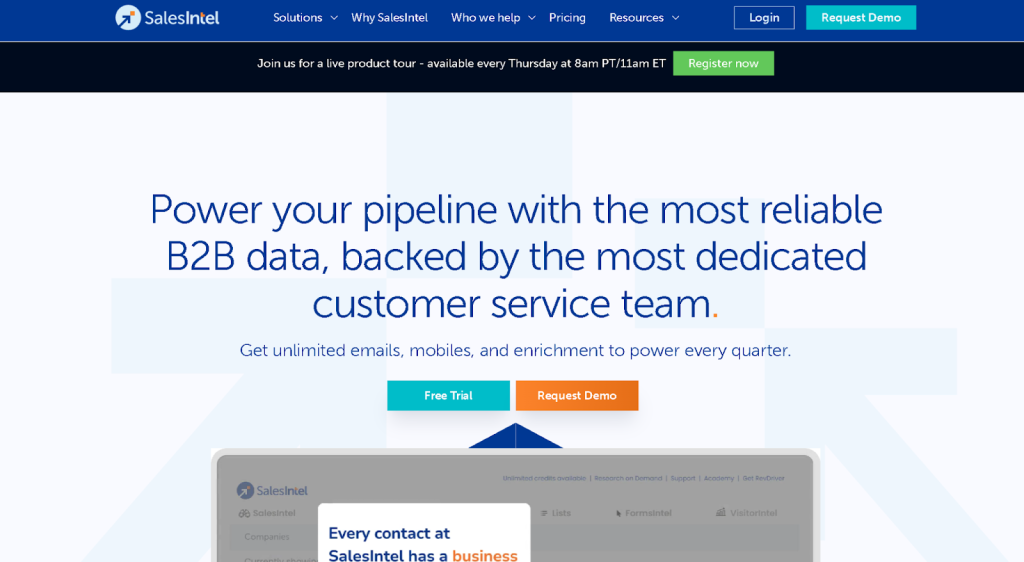
SalesIntel is a suitable software for buying email databases, with accurate and legally sourced contact information. They re-verify data every 90 days to ensure GDPR and CAN-SPAM compliance. SalesIntel allows you to target by industry, job title and company size and has dedicated customer support to improve your email marketing.
Pricing
-
- All plans: Custom, quote-based pricing – request a demo/quote
-
- Packages typically include unlimited data and enrichment with unlimited users plus Research-on-Demand credits.
Features
-
- B2B Data: SalesIntel gives you curated B2B contact and account data, re-verified every 90 days for high accuracy.
-
- Legal Compliance: All contacts are opt-in and sourced legally (GDPR and CAN-SPAM compliant)
-
- Targeted Outreach: The platform’s segmentation allows you to buy lists for marketing and target industries, job titles, company sizes and other attributes to reach out to targeted leads.
-
- Detailed Insights: SalesIntel gives you firmographic and technographic data so you can understand your prospects better and focus on the most promising accounts.
-
- Buyer Intent Data: Access to intent signals so you can prioritize accounts.
-
- Data Enrichment: SalesIntel can add accurate, up-to-date data to your CRM and lead forms.
Pros
-
- Human-verified data with strong accuracy
-
- Research on Demand service fills database gaps
-
- Exceptional customer support outperforms competitors
-
- Unlimited data access model benefits high-volume campaigns
-
- Smooth setup process
Cons
-
- Coverage gaps with limited data for many accounts
-
- International coverage weaker than US
-
- Data quality inconsistencies contradict accuracy claims
-
- Export limit frustrates large campaign managers
-
- Auto-renewal issues mirror industry patterns
⚖️ What I Like About SalesIntel
SalesIntel puts human research in the middle of its offer. The Research on Demand service helps when you work with a narrow account list and each contact slot matters. You can request specific titles at key companies and get them checked before you mail or call. That fits account based work where quality beats speed.
LeadIQ
Best for LinkedIn Capture and CRM Sync
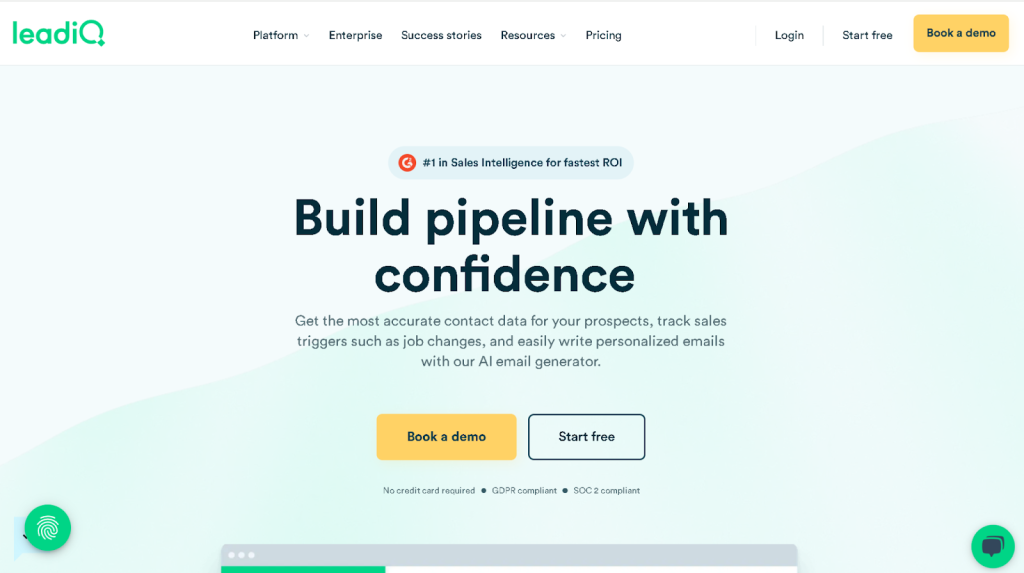
LeadIQ is a full platform for sales teams to buy email lists for marketing. It simplifies the process of finding and capturing B2B contact data so you can personalize outreach at scale.
With a focus on data accuracy, LeadIQ uses real-time verification and multiple layers of data verification from a mix of public and private databases, social media and user-contributed information.
So you have access to millions of verified profiles, emails and mobile numbers. LeadIQ also integrates with all major CRMs and sales engagement tools.
Pricing
-
- Free: $0
-
- Essential: from $20/user/month, or from $15/user/month when billed annually
-
- Pro: from $79/user/month
-
- Enterprise: Custom pricing
Features
-
- Contact Data: LeadIQ has millions of verified profiles, including emails and mobile numbers, checked in real-time for accuracy and quality.
-
- One-Click Workflow: Simplifies prospecting with a one-click workflow that integrates with your CRM and sales tools.
-
- AI Personalization: Enhances your outreach with AI written emails that are tailored to the recipient’s interests and needs.
-
- Integrations: Works with several sales and CRM platforms like Salesforce and Hubspot.
-
- Global Data Operations: A dedicated team enriches and verifies the database by researching new public data sources and vendors so you have global coverage.
-
- Data Verification and Compliance: Multiple verification layers and data privacy regulations like GDPR and CCPA compliance.
Pros
-
- Chrome plugin creates seamless workflow integration
-
- Top implementation index ranking with fast ROI
-
- AI-powered email templates increase response rates
-
- All-in-one approach costs less than enterprise alternatives
Cons
-
- Data accuracy undermines workflow gains with inaccuracy rates
-
- Wasted credits on bad data frustrate users
-
- Dashboard problems persist with buggy, slow interface
-
- Limited contact information availability affects phone prospecting
⚖️ What I Like About LeadIQ
LeadIQ removes a lot of manual work between LinkedIn and your CRM. You select prospects in Sales Navigator, click once and see them appear in Salesforce or HubSpot with emails and sometimes phone numbers. Job change alerts add a steady stream of warm reasons to reach out again. It suits SDR teams that live in LinkedIn and hate copy paste.
Skrapp.io
Best for LinkedIn Email Discovery at Scale
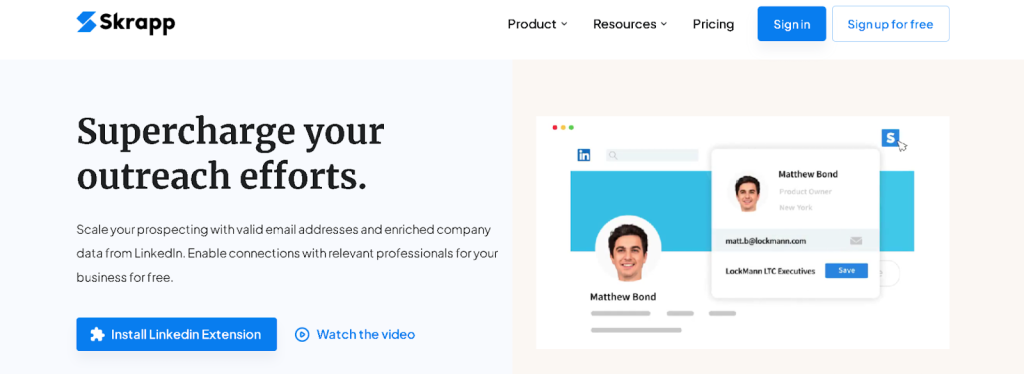
Skrapp.io is a B2B lead generation tool that gives you access to over 150M+ business profiles and company data for more than 20M+ businesses, updated daily. You can find verified business emails and enrich company data from LinkedIn and Sales Navigator in no time. With an 80% success rate in finding valid email addresses, it simplifies the process of buying email lists for marketing and sales purposes.
Pricing
-
- Free: $0
-
- Starter: from $30/month
-
- Seeker: from $375month
-
- Enterprise 20k: from $140/month
-
- Global 50k: from $225/month
Features
-
- LinkedIn Email Discovery: Find email addresses from LinkedIn and Sales Navigator and boost your email marketing.
-
- Email Verification: Verify your email lists and get high deliverability rates, reduce bounces and preserve your sender reputation.
-
- Advanced Filters: Filter your search with industry, company size, revenue and more to find the perfect prospects for your email campaigns.
-
- Bulk Email Extraction: Generate lists of potential leads with the bulk email finder and scale your email marketing.
Pros
-
- Fast email extraction with one-click access
-
- Chrome extension works seamlessly with LinkedIn
-
- Bulk search capability saves hours
-
- Domain search finds employees without specific names
-
- Smooth CRM integrations
Cons
-
- Email verification fails with verified emails bouncing
-
- Outdated email addresses from public sources
-
- Inconsistent customer support quality
-
- LinkedIn account blocking risk
-
- Platform limited to LinkedIn only
⚖️ What I Like About Skrapp.io
Skrapp.io makes bulk list creation from LinkedIn straightforward. You define your search, run the bulk finder and end up with a CSV you can clean and use. The pricing keeps it within reach for freelancers and small teams. It fits use cases where you need many emails fast and accept that you will run a separate cleaning step before a big send.
ZoomInfo
Best for Enterprise Grade Global B2B Database
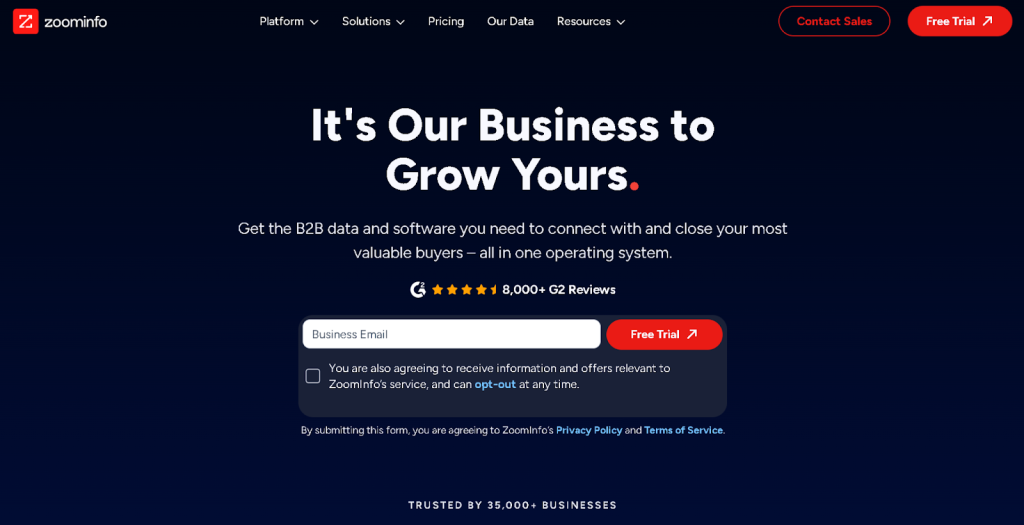
ZoomInfo is a platform to buy B2B contact data. It has direct dials and verified email addresses to reach potential buyers.
Professional profiles include job title, work experience, education and social media links, and you get notified when those profiles are updated.
Department/organization charts, decision-maker direct dials and emails and company initiatives are also included.
ZoomInfo’s B2B search engine has over 300 company attributes to search. Contact tracker will alert you to changes in buyers’ job title and company affiliation so you can keep your contact lists up-to-date.
Pricing
-
- Professional+: minimum $15,000/year
-
- Advanced+: custom, quote-based pricing
-
- Elite+: custom, quote-based pricing
Features
-
- B2B Contact Database: Get access to a database of 150 million verified email addresses and 65 million direct dial phone numbers.
-
- Advanced Search: Search for specific contacts and companies that match your Ideal Customer Profiles.
-
- Organizational Insights: Company profiles and org charts so you know the structure and key decision-makers at target companies.
-
- Browser Extension: Access ZoomInfo’s database from your browser with a Chrome extension
Pros
-
- Industry-standard database with comprehensive coverage
-
- Direct phone numbers prove valuable
-
- Strong contact accuracy for large companies
-
- User-friendly interface with convenient Chrome extension
-
- Seamless CRM integrations
-
- Intent data and buying signals help prioritize accounts
Cons
-
- Expensive pricing for SMBs
-
- Data accuracy issues undermine premium pricing
-
- International coverage weak
-
- Intent data proves inaccurate
-
- Aggressive contract practices create trust issues
-
- Customer service issues intensified recently
⚖️ What I Like About ZoomInfo
ZoomInfo brings depth on companies and org structures. You often see who reports to whom, which product they own and how the firm sits inside a larger group. That view helps you plan multi touch sequences across a buying committee instead of emailing one random contact. It suits larger sales teams that sell into complex accounts.
Lusha
Best for Simple Contact Data for SMBs

Lusha is a platform for purchasing business email addresses and offers millions of verified B2B contacts for email list purchases and outreach building. It’s GDPR and CCPA compliant and legal to use. Lusha is known for easy integration with major CRM systems and its simple sign up process.
Pricing
-
- Free: $0/month (includes up to ~70 credits/month for one user)
-
- Pro: from $29.90/user/month, or about $22.45/user/month when billed annually
-
- Premium: from $69.90/user/month, or about $52.45/user/month when billed annually
-
- Scale: Custom pricing
Features
-
- B2B Data: Get company and contact details to refine your sales approach and target better.
-
- CRM Data Enrichment: Add up to date contact and company data to your CRM and find new business.
-
- Advanced Search: Use advanced filters to create contact lists and find emails and direct dials fast.
-
- Integrations: Integrate Lusha with your existing CRM systems like HubSpot and Salesforce.
-
- Data Compliance: Lusha is GDPR & CCPA compliant.
Pros
-
- Strong data accuracy with low email bounce rates
-
- LinkedIn Chrome extension with seamless integration
-
- Exceptional ease of use
-
- Reduces prospecting time
-
- Smooth CRM integration
Cons
-
- Data quality paradox with polarizing accuracy reports
-
- Expensive compared to competitors with recent price hikes
-
- Hidden pricing elements shock users
-
- Customer service earns poor ratings
-
- Geographic performance varies
-
- Phone numbers not classified by type
Did you know? UpLead is known as one of the best Lusha alternatives.
⚖️ What I Like About Lusha
Lusha works well for quick lookups during research. You open a profile or a company page and pull direct dials and emails in a few clicks. The learning curve stays low, so new reps adopt it fast. It fits teams that do not want to train on a big platform but still need better data than what LinkedIn alone gives.
Seamless AI
Best for AI Based B2B List Tool
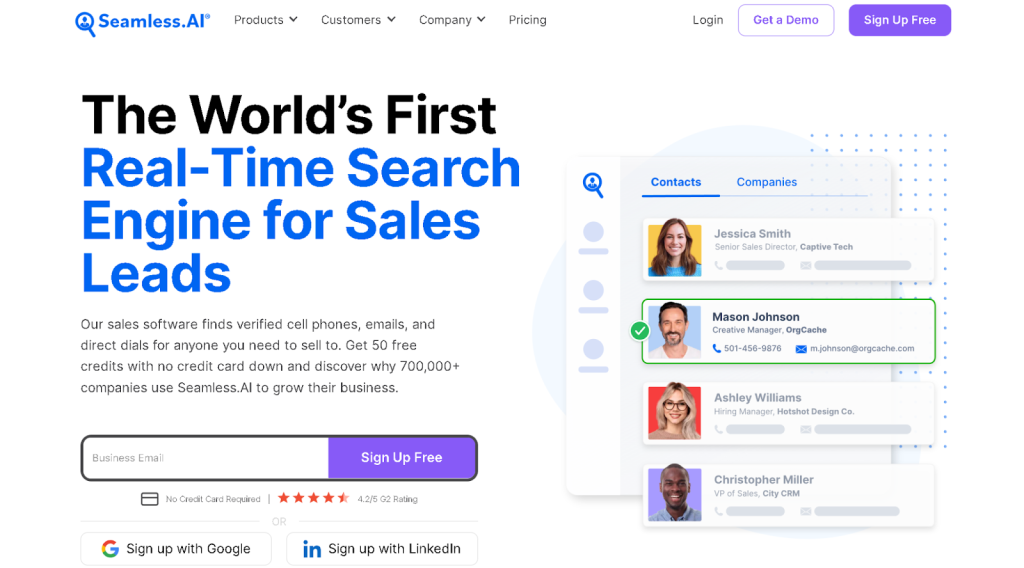
Seamless.ai is designed for generating accurate and compliant email lists and automates the process of finding and validating email addresses of key decision-makers. It’s suitable for sales, marketing and recruitment professionals to improve their B2B outreach.
Seamless.ai prioritizes real-time validation and marketing regulations. Their goal is to reduce the risk of bounced emails and reputation damage. Seamleass.ai offers an ethical way to expand your contact database.
Pricing
-
- Free: $0
-
- Basic: $147/user/month (billed annually)
-
- Pro: Custom pricing
-
- Enterprise: Custom pricing
Features
-
- Contact Data: Get access to a database with emails, phone numbers and detailed information about company decision makers.
-
- AI Lead Generation: Use AI to build email address lists. This feature automates the process of finding and validating email addresses of key decision makers.
-
- Custom Search: Use customizable search filters to find contacts by industry, revenue, job title, seniority and more.
-
- Data Enrichment: Fill in the gaps in your database with Seamless.AI’s data enrichment tool so your CRM and marketing automation platforms have the most current and complete data.
-
- Integrations: Integrate your new email lists into your CRM or marketing automation platforms or export as CSV files.
Pros
-
- LinkedIn integration via Chrome extension simplifies prospecting
-
- Easy-to-understand dashboard
-
- Access to direct dials and mobile phone numbers
-
- Smooth CRM integrations
-
- Sales training resources included
Cons
-
- Data accuracy below acceptable levels
-
- High email bounce rates
-
- Cancellation policy creates major trust crisis
-
- Buyer intent feature doesn’t work as advertised
-
- File export problems
-
- Hidden search quotas separate from credits
⚖️ What I Like About Seamless.ai
Seamless.ai focuses on volume. You can build large lists with filters for role, size and industry and send them on to your outbound tools. That plays well for teams that run many tests at the top of the funnel and rely on constant fresh contacts. It suits growth focused sales orgs that measure success in number of conversations started.
What Should You Look Out For When Buying Email Lists?
When buying email lists, you should look out for key factors such as data accuracy, database size, types of contact data and legal compliance.
Accurate Data
When you buy email addresses for marketing or sales, always check for accurate data. Accurate data is crucial for reducing bounce backs and ensuring marketing effectiveness. A good vendor like UpLead guarantees 95% data accuracy. This reduces bounce backs and ensures your marketing reaches the right people.
Pro Tip: Always ask for a data accuracy guarantee from your list provider to get the most out of your marketing.
Database Size
Size of the database matters because it determines how many contacts you can reach. UpLead has over 180 million leads so you have plenty of email data lists for targeted campaigns. Most vendors allow you to buy email lists by industry to make sure the marketing list fits your specific sector (If you focus on B2C outreach, consider options to buy consumer email lists)
Pro Tip: Focus on the relevance and quality of the database rather than just the size to get the most valuable leads for your business.
Types of Contact Data
Different vendors offer different types of contact data, some offer email addresses and some offer phone numbers like UpLead does. This gives you more options for your marketing strategy. Look for email list companies like UpLead who offer extensive lists of email addresses that are refreshed in real time.
Pro Tip: Make sure you get a list that has multiple types of contact info to diversify your outreach.
Legal Compliance and Opt-In Email Lists
If you purchase email lists, you get instant access to thousands of contacts, it’s crucial to verify quality and compliance. Following legal standards like GDPR, CASL and CAN-SPAM is crucial to avoid fines. These regulations dictate how you can use purchased email lists.
Pro Tip: Make sure your list provider complies with the laws to protect your business.
Reputation of Vendor
The vendor’s reputation is a good indicator of list quality. An email list company with a good reputation will provide up-to-date and legal compliant email lists.
Pro Tip: Do your homework by reading reviews and researching potential vendors before you buy email data to get the best list.
Exclusive List
Email lists are not always exclusive meaning the same contacts can be targeted by multiple companies. This can lead to lower engagement rates and waste of your investment.
Pro Tip: Look for lists that are exclusive or targeted to your niche to get more out of your campaigns.
Email Deliverability and Verification
Email deliverability is key to your campaigns and list purchase strategy. Buying low-quality lists can damage your sender reputation and get your emails marked as spam.
Pro Tip: Use email verification tools to clean your lists before launching campaigns to maintain high deliverability rates and filter out invalid email addresses.
Why Should You Buy Email Lists Only From Verified Sources?
Buying from verified sources means you’re following the law, protecting your deliverability and IP reputation and keeping your email marketing legit and performing.
-
- Legal: Buying from verified sources means you’re following the law like GDPR which requires explicit consent. Ignoring this can mean big fines and brand damage.
-
- Deliverability: Cleaner lists from verified sources means less chance of high bounce rates and spam traps. This protects your sender reputation so your emails land in the right inboxes.
-
- Reputable Email Service Providers (ESPs): Most ESPs require opt-in lists. Buying from verified sources meets this requirement so you won’t get penalized or have your email service disrupted. Email service providers have strict policies against purchasing email lists due to potential negative impacts on deliverability and brand reputation.
-
- Quality of Contacts: Verified sources are more likely to have email leads lists with real interested contacts. This means more positive engagement from recipients.
-
- Accurate Data: Verified sources provide accurate data and ensure up-to-date and reliable contact information to help qualify and engage leads in your marketing strategies.
-
- Brand Reputation: Using verified lists minimizes the risk of looking spammy by making sure recipients have interacted with or shown interest in your business before.
-
- Customer Trust: Verified lists help build and maintain trust. Recipients are more open to engage with content from sources they have connected with.
How Can Purchased Email Lists Help You?
Buying an email list gives you instant access to a big audience and speeds up the targeting process. These lists allow you to reach people based on job titles or demographics so you can connect with a relevant audience without having to build your own list from scratch. Reaching the right target audience through targeted email lists is crucial for improving your email list marketing results.
By using these pre-made lists you can focus on your message rather than spending resources on gathering contacts. Owning opt-in email addresses ensures compliance and using the right email list for marketing will help you reduce unsubscribes and drive traffic.
This instant access is valuable for launching a marketing campaign or entering a new market where time is of the essence. (This way, you don’t need to set up a landing page to capture contact information from website visitors first. You can just go ahead and start your campaign.)
Plus targeting specific demographics or job titles means your message will resonate more with the recipients and get higher engagement rates.
Just be sure to navigate the legalities and make sure your strategies align with best practices and these lists can be a powerful tool in your marketing toolbox.
FAQ About Buying Email Lists
Here are the answers to common questions about buying email lists:
Email lists are the product of lead generation techniques. They typically have email addresses and include info such as the owner’s name and other data relevant to email marketing.
Email lists are usually generated through lead-generation tools. These tools generate email addresses based on the user’s target audience. It then shows the user’s potential leads and allows them to download up-to-date data for their email marketing efforts.
Email lists are best when bought from lead generation tools. Good lead generation tools give users email addresses and relevant, up-to-date data they can use to send the right marketing messages.
It is not illegal to buy an email list. Legality has more to do with how email addresses are used. For example, emails should always offer ways to opt out of the email database.
Buying the right email list will pay for itself properly and will be generated far faster than an opt-in email database. The right tools enable you to purchase reliable and profitable email lists. You can also build free email lists, but it takes time and effort.
Yes, multiple lead generation tools have location criteria like city and postal address that allow you to access leads based on their zip code and buy email lists by industry.
Yes, when using a reputable data provider that offers reliable mailing addresses, buying mailing lists can be worth it.
You should ook for guarantees on data accuracy, legal compliance, and regular updates.
No, cheap email lists are not a good idea. While they might seem cost-effective, these cheap email marketing lists often compromise on accuracy and compliance, leading to higher bounce rates.
By definition, email lists typically contain only email addresses, while contact lists contain more comprehensive information such as names, phone numbers, job titles and company details in addition to email addresses.
Build a clean and profitable list
As we’ve seen, not every email list provider lets you buy the right addresses for your email campaigns. Before you purchase an email list, make sure that the data is up-to-date and that the provider complies with all legal standards.
UpLead offers a 95% accuracy guarantee and all the features (such as advanced search filters) you need to buy the best email lists for your marketing campaigns and business growth.
Additionally, with UpLead’s intent data, you’ll get ready-to-buy leads that are more likely to close.
Get started with UpLead today. 👇
Lead generation doesn’t have to be all that painful. With UpLead, you can easily connect with high-quality prospects and leads to grow your company.







